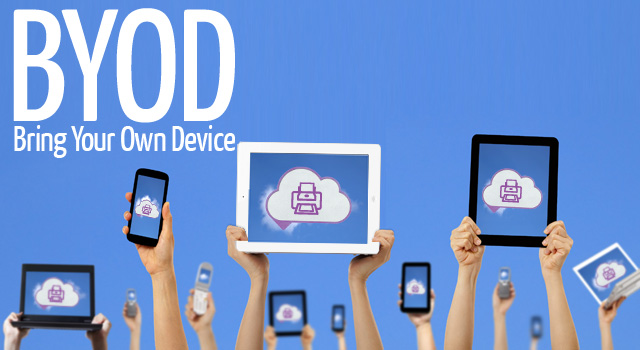Bring your own device (BYOD)—also called bring your own technology (BYOT), bring your own phone (BYOP), and bring your own PC (BYOPC)—refers to the policy of permitting employees to bring personally owned mobile devices (laptops, tablets, and smart phones) to their workplace, and to use those devices to access privileged company information and applications. The term is also used to describe the same practice applied to students using personally owned devices in education settings.
 • Learn from Others. Before launching a BYOD initiative, visit other schools that have implemented similar programs in order to scout out ideas, anticipate challenges and determine what will work in your own setting.
• Learn from Others. Before launching a BYOD initiative, visit other schools that have implemented similar programs in order to scout out ideas, anticipate challenges and determine what will work in your own setting.
• Make it a Team Effort. It is essential for curriculum and technology leaders to work together on planning and implementing a new initiative. Offer plenty of opportunities for teachers to collaborate and share resources and ideas, both online and in person.
• Give Teachers the Devices First. Allowing teachers at least a six month “head start” before roll-out gives them the chance to get comfortable with the new technology and explore its role in the curriculum.
• Encourage Students and Teachers to Take Risks. Although it is easier to say than to do, innovation requires a culture in which it is safe to experiment with new approaches without being judged or punished if the results don’t live up to initial expectations.
• Focus on Infrastructure. When it comes to BYOD, most would agree that you can never have too much bandwidth! Anticipate multiple devices per person in use on your wireless network at any one time.
• Have Backup Plans. You can expect student and teacher devices to break and be unusable at times. It’s important to have extra devices on hand and a system for loaners or replacements. Technical support and repair services need to be readily available, with quick turnaround times.
• Establish Clear and Consistent Policies and Routines. Teachers and students should know what’s expected of them when it comes to the use of technology in and out of school. Establish consistent procedures for downloading and uploading assignments, storing and charging devices, and so on.
• Educate Parents. Offer ways for parents to learn about the tools their children will be using at school and at home, as well as the policies they will be expected to comply with.
• Families Should Have “Skin in the Game”. Charging a small annual “use” or insurance fee is very common for programs. This not only helps to defray costs, but also builds a sense of responsibility for the devices. Consider volunteer alternatives for those who can’t afford the fee.
• Set Realistic Expectations: Having clear goals and metrics for measuring progress is important. At the same time, be realistic about what is possible. A BYOD implementation is not necessarily going to improve test scores—at least not at first. Don’t over-promise.

Leave a Reply